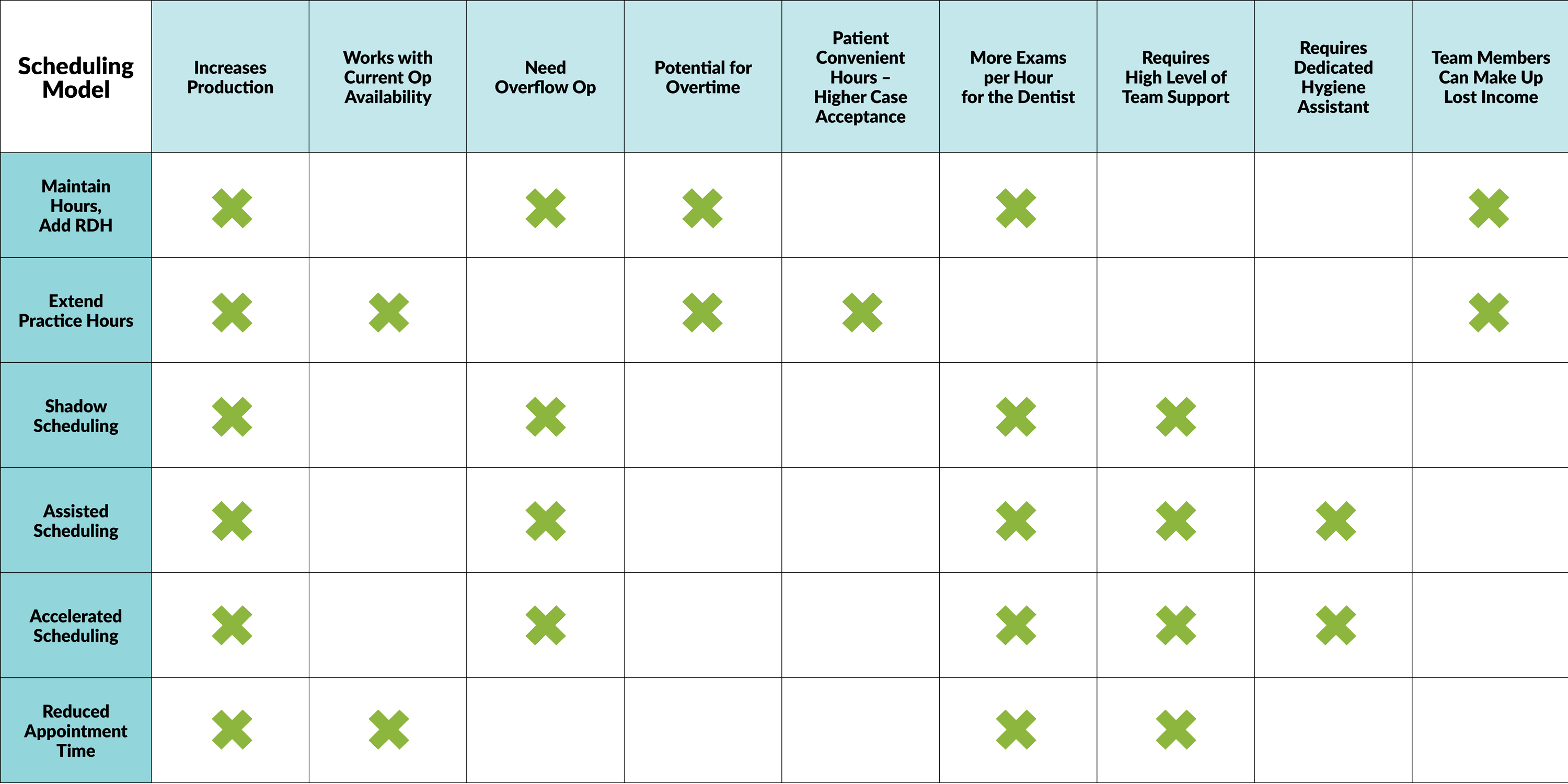Hygiene Scheduling Options
Dentists face an ongoing challenge in maintaining a full and productive schedule for hygiene patients. Practices may consider alternative scheduling models of care for the following reasons:
- No-show and cancellation issues disrupt the day’s schedule affecting office productivity and revenue. Despite starting the day with a well-planned schedule, unexpected cancellations can throw things off balance.
- Lack of available hygiene appointments to meet patient demand impacts customer service. Exceptional customer service plays a pivotal role in patient retention. Patients who are unable to make appointments for needed care may feel undervalued.
- Unexpected staff shortages due to illness, vacations, turnover, or other reasons can disrupt the regular hygiene schedule. Having contingency plans in place, such as alternative schedules, ensures that patients can still be seen even with reduced staffing.
- Improve time management, efficiency, and increase productivity. An assisted hygiene model, for example, supports more efficient patient care and higher production.
- By strategically designing schedules, practices can maximize available resources, minimize downtime, and ensure effective utilization of staff and operatory space. Read more about best health care scheduling practices.
Dentists must balance patient value, efficient scheduling, and personalized care to optimize hygiene appointments and minimize disruptions. The table below provides insight into a variety of hygiene scheduling possibilities.

Maintain Current Practice Hours – Add Hygiene Care Hours
Adding additional hygiene hours is the simplest approach to meeting demand. Monitor overtime issues by following your state guidelines for overtime pay. When operatory availability supports additional hygienists, you may not need to extend practice hours. Part-time hygienists may want to work additional hours in order to make up for lost wages, or it may be possible to hire a temporary hygienist to meet demand. Consider the following when adding additional hygiene care hours:
Wins |
Considerations |
|---|---|
| No changes occur with support staff, including front office team members and dental assistants, since your normal practice hours do not change.The dentist must be able to provide an additional exam per hour. | The dentist must be able to provide an additional exam per hour. |
| The hygienist is provided the opportunity to make up lost hours due to the temporary closure. | You assume patients are willing to schedule during normal work hours; some patients may be reluctant to miss work hours if they lost hours themselves during the pandemic. |
| Lessens the possibility of overtime for support staff. | Op availability must support an additional hygienist during normal practice hours. |
Extend Practice Hours
Extend the current practice hours temporarily to increase hygiene opportunities. Extended hours will also support added convenience to patients that may be hesitant to miss work, especially if they recently returned to work due to a COVID-19 interruption. This includes evening hours and Saturdays.
Wins |
Considerations |
|---|---|
| Op capacity should not be a challenge. | Hygienist(s) must be available and willing to work extended hours. |
| The dentist can extend restorative opportunities or just be available for hygiene exams during extended hours. | Overtime monitoring must be in place, as additional front office team members must be available, as well as added hygienists. Front office team members may stagger schedules to avoid overtime. |
| Provides the highest convenience to patients when extended hours are offered in the evening and on Saturdays. | |
| Team is provided the opportunity to make up lost hours due to the temporary closure. | |
| Extended hours allows you to prioritize impacted patients during your temporary closure. |
Shadow Scheduling (Limited, Strategic Overbooking)
It is common for a practice to experience a 10-20% last-minute cancellation rate on any given day. Shadow scheduling creates a managed plan to strategically double book hygiene. The practice must take a team approach when utilizing this strategy; multiple team members need to be able to pitch in when a double booking occurs.
Wins |
Considerations |
|---|---|
| Does not require additional hours from staff or overtime monitoring. | Must have an overflow hygiene op available. |
| Minimizes losses from no-show appointments. | Not as dependably productive as assisted or accelerated hygiene. |
| Does not add patient-convenient hours. This may limit the treatment of additional patients when many return to work and do not want to miss additional time to accommodate a dental visit. | |
| The dentist must be able to provide an additional exam per hour. | |
| The entire team must be flexible and willing to work together. The system fails if the hygienist is the only one stretching to see two patients in the hour without support. |
Rules for overbooking include:
- Do not create a shadow appointment in these situations:
- Prime hours that are easy to fill, such as early morning and late afternoon
- Patient requests a specific hygienist
- A scaling and root-planning patient or difficult periodontal maintenance procedure is confirmed at the same time
- Do create a shadow appointment in these situations:
- Mid-morning and mid-afternoon hours
- Next to an unconfirmed appointment
- When the patient does not have a hygienist preference
- Prophy appointments
The team strategizes at the morning huddle to determine who will provide support to the hygienist to accommodate the extra patient. Keep in mind, this requires more than just seating the additional patient; a support person will commit to working with the hygienist throughout the hour to seat the patient, check health history, take blood pressure, update films (where allowed), record exam notes, polish (where allowed), floss, provide homecare instructions, and schedule the next hygiene visit. The hygienist will stagger his/her time to provide scaling for both patients.
(For additional information and scheduling templates, see “Shadow Scheduling” resource.)
Assisted Hygiene
Assisted hygiene provides additional opportunities within the current practice hours. This schedule works well when there is a high prophy demand.
Wins |
Considerations |
|---|---|
| 12 patients are scheduled in an 8-hour day. | Operatory availability must support two ops for each hygienist working in an assisted scheduling model. |
| Assisted hygiene increases daily hygiene production by 50%. | A dedicated hygiene assistant is required and works with the assigned hygienist. |
| The assistant must have excellent technical and verbal skills to support a high case acceptance rate for diagnosed treatment. | |
| The hygiene assistant is responsible for seating the patient, checking health history, taking blood pressure, exposing films (where allowed), recording exam notes, polishing (where allowed), flossing, applying fluoride (where allowed), providing homecare instructions, and scheduling the next hygiene visit. | |
| The hygienist will stagger his/her time to provide scaling for both patients.
Communicating exam findings and maintaining a healthy case acceptance rate will need continual monitoring. |
- In practices with two hygienists, a hygiene assistant can provide assisted hygiene in the morning for one hygienist and assisted hygiene in the afternoon for the other hygienist. This opens opportunities to schedule SRP and periodontal maintenance visits with the hygienist that is not managing the assisted schedule. Each hygienist provides assisted hygiene for half a day, creating less hesitation and resistance from the hygienist.
(For additional information and scheduling templates, see “Assisted Hygiene” resource.)
Accelerated Hygiene
Accelerated hygiene provides twice as many hygiene opportunities as compared to traditional hygiene, and 50% more opportunities than assisted hygiene. Additional opportunities fit within the current practice hours. This scheduling model is not conducive for practices that focus on relationship building with patients and periodontal care. It is ideal for a high volume, prophy based patient base. It is commonly used in Medicaid practices that require a high volume of patients in a shorter period of time due to low reimbursement rates for services.
Wins |
Considerations |
|---|---|
| 16 patients are scheduled in an 8-hour day. | Operatory capacity must support two ops for each hygienist working in an assisted scheduling model. |
| A dedicated hygiene assistant is required. | |
| The assistant must have excellent technical and verbal skills to support a high case acceptance rate for diagnosed treatment. Communicating exam findings and maintaining a healthy case acceptance rate will need continual monitoring. |
|
| The speed of this schedule will require additional monetary rewards for the hygienist; it can also create a fast burnout rate. | |
| Relationship building and loyalty is lowest in this model of care. |
(For additional information and scheduling templates, see “Accelerated Hygiene” resource.)
Reduced Appointment Time
Scheduling 50-minute appointments instead of 60 minutes will provide two additional hygiene opportunities in an 8-hour day.
Wins |
Considerations |
|---|---|
| Operatory capacity is not a challenge. | Requires an efficient hygiene team and support staff to help the hygiene team stay on time. |
| A scheduled break can occur for hygienists. | The doctor must provide efficient exams that are on time. |
(For additional information and scheduling templates, see “50-minute Appointments” resource.)

